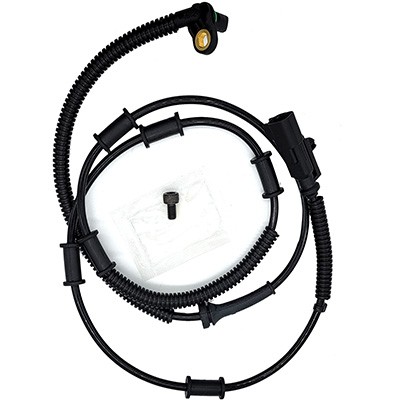Driving with a malfunctioning Abs Brake Sensor can compromise your safety. This critical component ensures your vehicle stops correctly and maintains stability in challenging conditions. Understanding its function and recognizing the signs of a failing sensor are crucial for safe driving. Replacing a faulty ABS brake sensor is a vital step in maintaining your vehicle’s braking performance.
What is an ABS Brake Sensor and How Does it Work?
ABS stands for Anti-lock Braking System. The ABS brake sensor is a key part of this system, preventing wheel lock-up during hard braking. These sensors, powered by the battery and alternator, constantly monitor the speed of each wheel. This data is transmitted to the ABS controller. If a wheel is about to lock up, the controller signals the ABS pump to modulate brake pressure, preventing skidding and maintaining steering control. This is especially important on slick surfaces like ice or wet roads.
Recognizing a Bad ABS Brake Sensor: Key Symptoms
A failing ABS brake sensor often exhibits noticeable symptoms. Be aware of the following warning signs:
- Illuminated ABS Warning Light: The most obvious indicator is the ABS warning light on your dashboard.
- Vehicle Pulling or Veering: When braking, the car might pull to one side or veer off course.
- Spongy or Unresponsive Brakes: The brake pedal might feel soft or less responsive than usual.
- Increased Stopping Distance: You might notice that it takes longer to bring the vehicle to a complete stop.
When to Replace Your ABS Brake Sensor
Driving with a faulty ABS brake sensor significantly reduces your ability to control the vehicle during sudden stops, especially in adverse weather conditions. While driving without ABS is possible, as older vehicles lacked this system, it’s not recommended for cars equipped with it. ABS enhances safety and control, and its absence increases the risk of accidents. Replacing a bad ABS brake sensor should be prioritized for optimal safety. Although a DIY replacement is possible, professional mechanics possess the expertise and tools to ensure proper installation and functionality.
Driving Without ABS: Understanding the Risks
While brakes function even without a working ABS, the risks of skidding and losing control increase significantly, particularly in emergency situations or on slippery roads. In such cases, pumping the brakes gently can help prevent wheel lock-up and maintain some control. However, this technique is less effective than a functioning ABS. A working ABS brake sensor is crucial for maintaining optimal braking performance.
Importance of Regular Vehicle Maintenance for ABS Brake Sensor Health
Regular vehicle maintenance, including brake inspections, is essential for detecting potential ABS issues early on. A professional mechanic can identify a failing ABS brake sensor before it leads to more serious problems. Routine brake checks encompass inspecting ABS sensors, brake pads, and rotors, ensuring the entire braking system operates correctly and preventing unexpected failures.
Consequences of Ignoring a Bad ABS Brake Sensor
Ignoring a faulty ABS brake sensor can have severe consequences:
- Extended Stopping Distances: A malfunctioning sensor hinders the ABS system’s ability to adjust brake pressure optimally, leading to longer stopping distances and increasing the risk of collisions.
- Loss of Vehicle Control: Without a functional ABS, hard braking or sudden maneuvers can result in skidding and loss of control, making accidents more likely.
- Increased Accident Risk: The combination of longer stopping distances and reduced control significantly elevates the risk of accidents, especially in challenging driving conditions.
Any indication of a bad ABS brake sensor, such as the ABS warning light, should prompt immediate professional inspection and necessary repairs. Addressing this issue promptly is crucial for ensuring your safety and the safety of others on the road.

